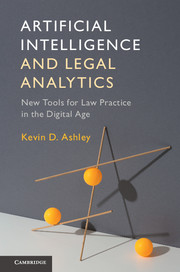Book contents
- Frontmatter
- Dedication
- Contents
- List of illustrations
- List of tables
- Acknowledgments
- PART I COMPUTATIONAL MODELS OF LEGAL REASONING
- 1 Introducing AI & Law and Its Role in Future Legal Practice
- 2 Modeling Statutory Reasoning
- 3 Modeling Case-based Legal Reasoning
- 4 Models for Predicting Legal Outcomes
- 5 Computational Models of Legal Argument
- PART II LEGAL TEXT ANALYTICS
- PART III CONNECTING COMPUTATIONAL REASONING MODELS AND LEGAL TEXTS
- Glossary
- Bibliography
- Index
5 - Computational Models of Legal Argument
from PART I - COMPUTATIONAL MODELS OF LEGAL REASONING
Published online by Cambridge University Press: 13 July 2017
- Frontmatter
- Dedication
- Contents
- List of illustrations
- List of tables
- Acknowledgments
- PART I COMPUTATIONAL MODELS OF LEGAL REASONING
- 1 Introducing AI & Law and Its Role in Future Legal Practice
- 2 Modeling Statutory Reasoning
- 3 Modeling Case-based Legal Reasoning
- 4 Models for Predicting Legal Outcomes
- 5 Computational Models of Legal Argument
- PART II LEGAL TEXT ANALYTICS
- PART III CONNECTING COMPUTATIONAL REASONING MODELS AND LEGAL TEXTS
- Glossary
- Bibliography
- Index
Summary
INTRODUCTION
In the last decades, much of the AI & Law research community has focused on developing comprehensive computational models of legal argumentation (CMLAs). Researchers have now integrated into these CMLAs a number of the computational models of legal reasoning presented in the preceding chapters.
An argument model consists of a representation of the elements of an argument and a specification of its semantics. Argument elements include the argument itself and, possibly, statements or propositions in the argument, as well as their interrelations, for example as constituents of argument graphs. The argument semantics are specified through some well-defined process by which the status of the argument elements can be determined, for example, by inspection of the graph.
Researchers in AI have produced a variety of argument models that differ widely in the aspects of arguments they represent and in the way they specify the status of an argument.
For example, abstract argument systems, including the pioneering Dungean models, abstract away much of the structure of argumentation, simply representing arguments and attack relations between them (Dung, 1995). They specify criteria for determining the status of an argument, that is, whether an argument is acceptable, in terms of the absence of attacking arguments that are not themselves attacked. One can extend Dungean models to account for more complex argument phenomena. For instance, a widely used computational model of argument, ASPIC+, represents premises and conclusions and takes into account support as well as attack relations (Modgil and Prakken, 2014). The Value-based Argumentation Framework (VAF) (Section 5.4) also demonstrates building more complex argument phenomena, arguing about underlying values, and extending Dungean models.
Other argument models are designed to preserve structural aspects of arguments that may make them more intuitively accessible to practitioners. For example, Verheij (2009) has developed models of legal argument that employ the familiar Toulmin argument structures relating claims and evidence via warrants and backing. The Carneades model, discussed in Section 5.2, also preserves an intuitively accessible structure clearly distinguishing propositions and arguments that support a conclusion from those that attack it.
Information
- Type
- Chapter
- Information
- Artificial Intelligence and Legal AnalyticsNew Tools for Law Practice in the Digital Age, pp. 127 - 168Publisher: Cambridge University PressPrint publication year: 2017
